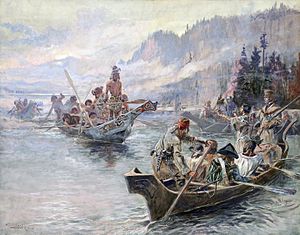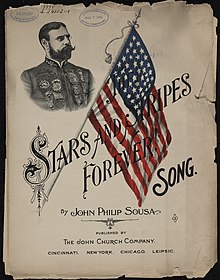Lewis and Clark Leave for the West, 1804
 |
| Meeting the Chinooks on the Lower Columbia. Watercolor by Charles Marion Russell, 1905. |
The first leg of the journey didn't go too badly. They averaged 15 to 20 miles per day. The territory was somewhat known here -- Lewis and Clark had read all the available accounts of French, Spanish, and Canadian fur traders, and they knew the general course of the Mississippi River.
The land that Lewis and Clark covered had been acquired by the United States the previous year, when Thomas Jefferson negotiated the Louisiana Purchase, adding approximately 530 million acres to US territory. 45 men set out on the journey, charged with mapping the terrain and reporting on the flora and fauna of the area. Remarkably, only one man perished on the journey, Charles Floyd, who died as a result of a burst appendix.
The trip was notable for a number of reasons. First of all, they achieved their objective, observing and writing descriptions of 178 types of plants and 122 species or subspecies of animals. They sent back packets to Jefferson whenever they could, and even sent him a prairie dog in a box, which arrived alive.
 |
| US Postage Stamp commemorating the 200th Anniversary |
Sacajawea, their Shoshone guide, also received a vote on group matters. She was useful to the expedition, not only for her guiding, translating, and survival skills, but because she convinced the tribes they met of the expedition's harmless intent. Since the group contained a woman, it was reasoned, they could not possibly be a war party.
The expedition, in total, cost the government $39,000. Jefferson had estimated, and Congress allotted, the sum of $2,500.
 |
| 1900 Sheet Music |
Stars and Stripes Forever First Performed Publicly, 1897
According to his autobiography, John Philip Sousa composed his best-known march, The Stars and Stripes Forever, on Christmas Day, 1896. He was on a ferry in Europe, and had just learned of the death of his friend and Sousa Band manager, David Blakely. He composed the march in his head, committing it to paper after he had returned to America to take charge of Band affairs. In 1987, it officially became the National March of the United States.Sousa displayed his musical talent and interest early. He began music study (on the violin) at the age of six, and was found to have perfect pitch. At the age of 13, his father, who was a trombonist in the United States Marine Band, arranged to have him enlist in the Marine Corps as an apprentice, apparently primarily to prevent him from joining a circus band. He served out his seven-year apprenticeship, learning to play all the wind instruments.
After his apprenticeship ended, Sousa joined a theatrical orchestra. It was there that he learned the art of conducting. A few years later he returned to the US Marine Band, this time as its conductor. He remained in that post for 12 years.
 |
| Sousa in 1900 |
Among Sousa's other compositions are: the official march of the United States Marine Corps, Semper Fidelis, The Washington Post, and The Liberty Bell, which you may recognize as the credits theme for Monty Python's Flying Circus. He wrote 136 marches, a number of operettas, three novels, and an autobiography.
No comments:
Post a Comment